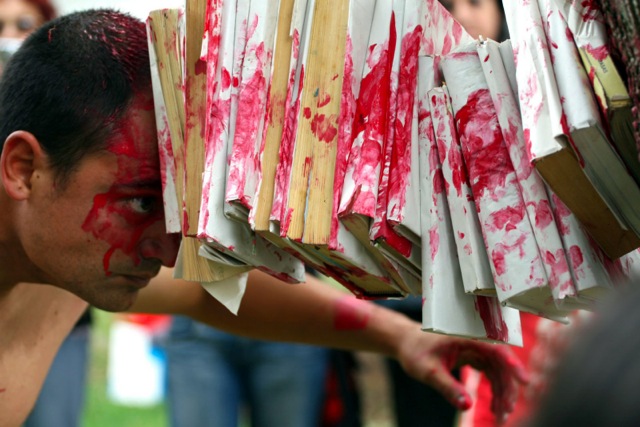
Unconstrained performances prevailed at the inaugural Miami Performance Festival
There is always a bit of trepidation when entering into an all-performance art event. When hastily produced and not well-thought-out, these can be straining – unlike a visual art show of similar (non) quality, it’s hard to just leave if you don’t like it. So the three-day inaugural Miami Performance Festival would be an experiment – great if it worked, best left unmentioned if not. Fortunately, the latter was the case (at least the performances we caught).
The Festival took place last weekend from Friday through Sunday. Friday was heavy on spoken word, while on Saturday several performances were remarkably silent – no words, no sound or music. Nice. Some pieces were based more on visual art than on dance, so even the movement was somewhat constrained. Artists from South America, the Caribbean, the United States and Canada took over spaces in the Design District and in the Botanical Gardens, and engaged the diverse crowds in various ways.
Colombian artist Eduardo Oramas hooked himself into a harness with elastic ropes. From this literally constrained position he tried to reach a cake on the floor. He jumped, he pulled, he exerted himself in all ways to reach that sweet. Then, he tried to pop the balloons hanging from the ceiling – he reached all but a red rogue, which became a Sisyphean task if there ever was one. Finally, he sat at a table, arms again tied to elastic straps that would only allow him so much easy movement, and drank a large plastic bottle of some kind of brightly colored soft drink. He burped, and then he succeeded.
Canada’s Irene Louglin.
Spanish artist Jessica Hirst was constrained in another way: members of the public painted her naked body with various adjectives relating to art and politics. Then, with sugar, flour and milk she attempted to cleanse herself of these markings – maybe trying to turn herself into a cupcake – only to give up and bring out a cake on which she wrote, “stigma.”
The most dramatic performance came from Argentine Gabriel Montero, who performed on a couple of nights. In one, lying face down in underwear on the floor, he pressed a two-by-four against the wall with his head, while a sexed-up video of a women’s seductive dance played on the wall in the corner intersection. As he violently pushed the wooden board into the concrete with his head, it started to bleed, at which point he stood and took a magic marker to trace his bleeding face on a piece of paper. Intense, and you had to be there.
Another artist, Alexia Miranda, clipped clothes-pins to her face while she read articles from the UN Declaration of Human Rights, and then tore them up – she asked the audience to help her, ending with the floor covered in bits of confetti-like paper.
There were numerous more performances and expressions from different cultures, making the free-form event something fresh and complementary to a scene in need of some spark.
Recent Content
-
Artsarticle ·
-
Artsarticle ·
-
Artsarticle ·


